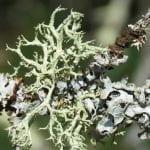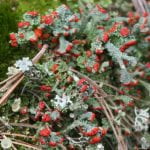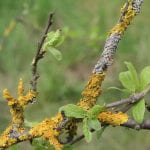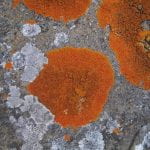 When you are outside this week, looking up, down, and all around, see if you can find some lichen. Lichen can be found growing on anything from trees to fences to rotting logs. There are over 13,000 species of lichen in the world and they come in a wide-range of colors and have very varied structures.
When you are outside this week, looking up, down, and all around, see if you can find some lichen. Lichen can be found growing on anything from trees to fences to rotting logs. There are over 13,000 species of lichen in the world and they come in a wide-range of colors and have very varied structures.
 So what is lichen? Is it a plant? Is it a fungus? Well actually, lichen is multiple organisms. It is composed of fungi and algae living together in a symbiotic relationship. Symbiosis or symbiotic relationships are close long-term relationship between two different species. When both species benefit from the relationship, it is know as a mutualistic symbiosis.
So what is lichen? Is it a plant? Is it a fungus? Well actually, lichen is multiple organisms. It is composed of fungi and algae living together in a symbiotic relationship. Symbiosis or symbiotic relationships are close long-term relationship between two different species. When both species benefit from the relationship, it is know as a mutualistic symbiosis.
Watch this short video to learn more about symbiosis.
 In lichens, the fungi form the body of the lichen providing support and protection for the algae, while the algae is able to harness the energy from the sun and use photosynthesis to make food for the fungi. As both the fungi and algae benefit from coming together to form a lichen it is considered mutualistic symbiosis.
In lichens, the fungi form the body of the lichen providing support and protection for the algae, while the algae is able to harness the energy from the sun and use photosynthesis to make food for the fungi. As both the fungi and algae benefit from coming together to form a lichen it is considered mutualistic symbiosis.
 When many people find lichens growing on their trees, they think the lichens are killing the trees. But as you now know lichens make their own food, so the trees are unharmed; trees are just a convenient place to grow.
When many people find lichens growing on their trees, they think the lichens are killing the trees. But as you now know lichens make their own food, so the trees are unharmed; trees are just a convenient place to grow.
So get outside and see if you can find some lichen! How many different colors and textures can you find? What surfaces is it growing on? Now that you know to look for it, you’ll begin to notice how common it is!
To further explore the world of lichens, check out these great articles.
 It Turns Out Lichen is a Trio Not a Pair
It Turns Out Lichen is a Trio Not a Pair
What’s Not to Lichen? Little Known, Little Understood?
Tree-Dwelling Lichens – Rutgers University Extension